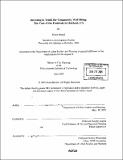| dc.contributor.advisor | Langley Keyes. | en_US |
| dc.contributor.author | Bernal, Diana, M.C.P. Massachusetts Institute of Technology | en_US |
| dc.contributor.other | Massachusetts Institute of Technology. Dept. of Urban Studies and Planning. | en_US |
| dc.date.accessioned | 2006-07-31T15:16:31Z | |
| dc.date.available | 2006-07-31T15:16:31Z | |
| dc.date.copyright | 2005 | en_US |
| dc.date.issued | 2005 | en_US |
| dc.identifier.uri | http://hdl.handle.net/1721.1/33606 | |
| dc.description | Thesis (M.C.P.)--Massachusetts Institute of Technology, Dept. of Urban Studies and Planning, 2005. | en_US |
| dc.description | Includes bibliographical references (leaves 88-90). | en_US |
| dc.description.abstract | In this thesis I explore how youth spatially perceive their environment in the Fruitvale, an inner city neighborhood in Oakland, California. Through my fieldwork I created a visual map of how youth view their spaces in the neighborhood and what constraints are being imposed on their space with little consideration. In studying the spatial patterns of youth my goal was to uncover the extent to which spatial constraints might be affecting their opportunities for positive development and integration into the neighborhood. I explored their situation within the context of a harsh-on-crime political climate in California over the past fifteen years. In the case of the Fruitvale historical economic and population shifts leading to the concentration of poverty, have caused the creation of informal aggressive subcultures involving drugs, gangs and prostitution. These have grown to dominate youth space on the street and have had large implications on safety. The lack of neighborhood safety is limiting the way youth use space, further limiting their access to greater neighborhood services which can potentially provide them with the support that they need to develop in positive ways and in their transition to adulthood. | en_US |
| dc.description.abstract | (cont.) Given the situation I focused on neighborhood strengths to develop recommendations for addressing the concerns of youth spatial safety. I found these strengths in the amazing work of neighborhood institutions. The Fruitvale neighborhood has a diverse concentration of institutions which have triggered many local changes to improve the conditions of residents. In my recommendations I propose expanding spatial safety by building on community strengths and lessons through the collaboration of neighborhood institutions. Using a similar concept to the Main Streets program currently existing on the eastern side of the neighborhood, I propose the creation of a Youth Empowerment Zone (YEZ) for community well-being. The YEZ would use physical, collaborative, and youth integration methods to link neighborhood institutions and provide a safe, fun and empowering spatial environment for youth while offering all the essential needs for positive youth development. | en_US |
| dc.description.statementofresponsibility | by Diana Bernal. | en_US |
| dc.format.extent | 103 leaves | en_US |
| dc.format.extent | 7994139 bytes | |
| dc.format.extent | 7998505 bytes | |
| dc.format.mimetype | application/pdf | |
| dc.format.mimetype | application/pdf | |
| dc.language.iso | eng | en_US |
| dc.publisher | Massachusetts Institute of Technology | en_US |
| dc.rights | M.I.T. theses are protected by copyright. They may be viewed from this source for any purpose, but reproduction or distribution in any format is prohibited without written permission. See provided URL for inquiries about permission. | en_US |
| dc.rights.uri | http://dspace.mit.edu/handle/1721.1/7582 | |
| dc.subject | Urban Studies and Planning. | en_US |
| dc.title | Investing in youth for community well-being : the case of the Fruitvale in Oakland, CA | en_US |
| dc.type | Thesis | en_US |
| dc.description.degree | M.C.P. | en_US |
| dc.contributor.department | Massachusetts Institute of Technology. Department of Urban Studies and Planning | |
| dc.identifier.oclc | 64181293 | en_US |
